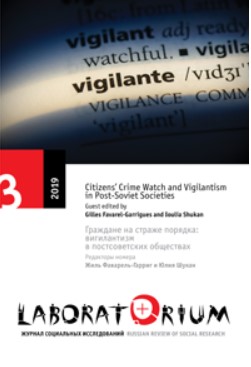Defending Ukraine at the Rear of the Armed Conflict in Donbas: Wartime Vigilantism in Odesa (2014–2018)
Defending Ukraine at the Rear of the Armed Conflict in Donbas: Wartime Vigilantism in Odesa (2014–2018)
Author(s): Ioulia ShukanSubject(s): Criminal Law, Military history, Criminology, Studies in violence and power, Present Times (2010 - today), Peace and Conflict Studies
Published by: Центр независимых социологических исследований (ЦНСИ)
Keywords: Vigilantism; Sociology of Violence; War in Donbas; Odesa, Ukraine;
Summary/Abstract: This article analyzes the phenomenon of vigilantism in Odesa, at the rear of the war in Donbas and in the context of a radical redeployment of the Ukrainian state and a redistribution of violence between state and non-state actors. This analysis is threefold. The first part provides a sociological account of vigilante groups and their members’ social backgrounds. It argues that vigilantism in Odesa has attracted people from four social backgrounds (businessmen, former combatants or security officers, far-right activists, and young people), relies on force-based actions, and implies an intense socialization of vigilantes’ bodies into the use of weapons and combat sports. The second part presents the three social roles of vigilantes—as national community guards, patrolling agents, and justice makers—and explores their associated practices. It shows that an apparently disinterested promotion of public good by vigilantes (security, order, justice) sometimes turns out to be for the benefit of private interests. The third part explores the complex relationship—fluctuating from numerous exchanges of services to a direct confrontatio —between vigilante groups and local political and economic elites. Finally, this article argues that the ongoing war has increased the value of vigilantes’ paramilitary resources and has provided them with a large measure of social recognition as a necessary and acceptable response to the armed conflict and its hybrid threats. However, this does not exclude public controversies around vigilantism and questions concerning the challenges it represents for the Ukrainian state. This article draws on anthropological approaches to vigilantism, as well as the sociology of violence and crisis situations (political crises, revolutions, intrastate wars); it relies on a combination of primary ethnographic research and secondary materials.
Journal: Laboratorium. Журнал социальных исследований
- Issue Year: 11/2019
- Issue No: 3
- Page Range: 71-104
- Page Count: 34
- Language: English

